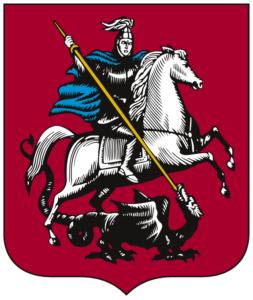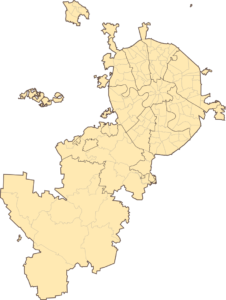 The city’s largest ever administrative and territorial division in its entire history, the project of the expansion of the territory of Moscow 2.4 times through annexation of the territories belonging to Moscow Region, was announced and presented by various mass media as early as 2011. The primary official purpose of the project was to dismantle the traditional ethnocentric structure of the Moscow agglomeration and organize the city-planning zones, awarding the recently annexed territories a distinct administrative and government specialization.
The city’s largest ever administrative and territorial division in its entire history, the project of the expansion of the territory of Moscow 2.4 times through annexation of the territories belonging to Moscow Region, was announced and presented by various mass media as early as 2011. The primary official purpose of the project was to dismantle the traditional ethnocentric structure of the Moscow agglomeration and organize the city-planning zones, awarding the recently annexed territories a distinct administrative and government specialization.

The mass media started calling the new territories “New Moscow,” reminiscent of “New Delhi,” the British project of modernizing the Indian capital, coincidentally celebrating its 100th anniversary in 2011. In both cases, the expansion of the capital was planned (and executed) in the Southwestern direction.
Many observers noted that the idea of expanding the boundaries of the capital was voiced back in 2010 by Dmitry Medvedev, then president of Russia. It presents a challenge to give more detailed information on this as no reliable resources are available.
“New Moscow,” the largest and most ambitious project in the country, was causing diverse reactions among the population as a whole as well as among the officials. According to a survey conducted in July 2011, 41% of interviewed Muscovites favored the expansion, 41% were against it, and 18% found the question hard to answer.
After the official expansion of its administrative boundaries on 1 July 2012, Moscow rose from 11th to 6th place in the ranking of the world’s largest cities according to their area. However, it remained 7th in population since the annexed territory is home to fewer than 250,000 citizens. At the end of 2016, Moscow held the most significant European capital title.
Due to the territory of Moscow being situated in an enclave of the Moscow region, it was decided that the regional area was to be included in the capital area.
The primary direction of the development of New Moscow was south and southwest. According to the press release of the Moscow City Government, this decision is dictated by:
the optimal location of this territory in terms of city planning, transport, and ecology to carry out the functions of Moscow;
There is a relatively low level of urbanization in that sector, which is currently home to 250,000 people with only 12 million sq. meters of housing available.
Initially, there were plans to include around 144 thousand hectares of land into the city’s territory, which would have expanded it from 107 thousand to 251 thousand hectares, or 2.35 times. On 18 August, the announced area of the annexed territories was increased to 160 thousand hectares (in other words, making it 2.5 times more prominent).
According to the final decision, the area of the annexed territory is 148 thousand hectares, meaning a 2.39 expansion of the territory of Moscow due to the project.
The adopted document includes 21 entire municipalities in Moscow’s territory. Apart from the Southwestern area, three territories, part of which are cut off from the central part of the city, were also annexed. They are Skolkovo, Rublevo-Arkhangelskoe, Rublevo-Uspenskoe, and part of the Machikhino territory of the Kievsky settlement.
In the minds of the project designers, the emergence of New Moscow was meant to create 1 million new jobs and provide housing for 1.5 million people.
According to one agency, 11 trillion rubles was invested into the development of New Moscow (16 billion rubles were spent on geodesic studies on the territory of new city areas, 32 billion rubles went towards engineering design and producing a general layout, 1.1 trillion rubles were spent on purchasing the land plot for future construction and 9.35 trillion rubles were spent on building itself.
After almost ten years of territorial debate, an essential event that preceded Moscow’s expansion was the adoption of a corrected border between Moscow and the Moscow Region in July 2011.
On July 28, 2011, the Moscow City Duma passed a law “On the peculiarities of organizing local self-government in municipalities included in the inner-city territory of the city of Moscow as a result of changes made to the border of the city of Moscow…”.
According to Article 1 of that law, the annexed municipalities of the Moscow Region retain their name and borders as well as “matters of local significance,” the structure of local self-government authorities, municipal property, and sources of income for the local budgets. The local self-government authorities (deputy councils, administrations, heads of city or rural settlements) of the annexed municipalities retain their power until the termination date stipulated in their documents.
Guarantees for the owners of allotments and garden plots are outlined in Article 2 of that law, which stipulates that it is obligatory to consider the owners’ opinions when making decisions regarding the development of the annexed municipalities.
On December 7, 2011, at an extraordinary meeting of the Moscow City Duma, the ruling “On the adoption of the Agreement on the change to the border between territorial entities of the Russian Federation, the city of Moscow and Moscow Region” was approved. This Agreement includes 21 municipalities in Moscow’s territory, including two urban districts, 19 city and rural settlements in the Southwest, and three partial territories west of Moscow.
On December 27, 2011, the Federation Council approved this Agreement.
The transitional period of handing the territory over came into effect immediately upon the approval of the ruling on adopting the Agreement on the change to the border between territorial entities of the Russian Federation, the city of Moscow, and the Moscow Region and lasted until July 1, 2012.
On March 19, 2012, the mayor of Moscow, Sergey Sobyanin (Mayor of Moscow), introduced a series of legislative acts to the Moscow City Duma, which determined the administrative and territorial structure of the new territories of Moscow after its expansion on July 1, 2012.
Before its expansion, Moscow was divided into 125 inner-city municipalities or districts. The legislative acts proposed by Mayor Sobyanin concerned renaming districts into municipal districts and also renaming the municipalities that have been included into Moscow: city districts (there are two: Troitsk and Scherbinka) will be called “city districts” while city and rural settlements will adopt the general term “settlement” (without division into city or rural settlements). They are Vnukovskoe, Voronovskoe, Voskresenskoe, Desyonovskoe, Kievsky, Klyonovskoe, Kokoshkino, Krasnopakhorskoe, Marushkinskoe, Mikhaylovo-Yartsevskoe, Moskovsky, Mosrentgen, Novofyodorovskoe, Pervomayskoe, Rogovskoe, Ryazanovskoe, Schapovskoe, Filimonovskoe, and Sosenskoe.
This allowed the city of Moscow to follow through with its law on the peculiarities of organizing local self-government in the territories annexed to Moscow. According to that law, all the municipalities existing at the time of annexation retain the status and powers they had before the annexation.
After the annexation, all dacha communities, villages, rural communities, settlements, and cities ceased to be territorial units (as they were when they were part of the Moscow Region) since only “city districts” and “settlements” have their municipal self-government authorities remain territorial units.
The Moscow government decided to create two additional administrative districts (before July 1, 2012, Moscow contained ten such districts) on the annexed territories. There was public debate regarding the names of those districts. On April 17, 2012, the names of the districts were established, and it was decided that during the transitional period, both districts would have a single prefecture – the Prefecture of the Troitsk and New Moscow administrative districts (TiNAO) and a prefect was appointed.
On May 22, 2012, it was decided to create a new department within the Moscow City Government – the Department of the Development of the New Territories of Moscow.
The department is faced with rather challenging tasks since it is projected that by 2035, the population of the New Moscow and Troitskiy districts will grow to 1.5 million. The plan is to take a multicentric approach to developing the new territories, the concept being to create 12 centers of city planning activity (“points of growth”) in the regions adjacent to the inhabited localities of New Moscow.
The most realistic assessment of the development, quality of life, and prospects of New Moscow are published by independent public media: «New Moscow» and «TiNAO».
